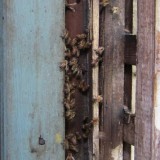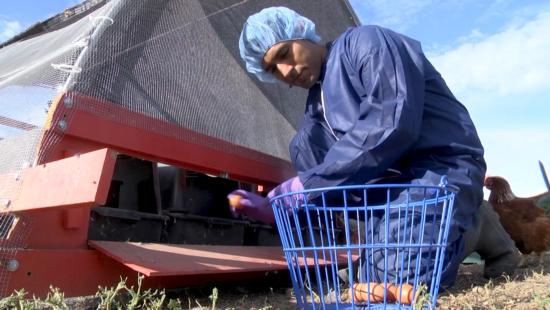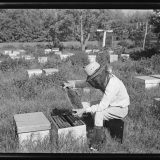
A Typical Natural Bee Nest from: Seeley, T. D., Morse, R. A. (1976).
If honeybees lived without us humans, they’d naturally set up their digs in the hollow cavity of a tree. Honeybees like a dark and secure space with a small defensible entrance. A tree cavity is the perfect place to avoid a hive’s two main predators: bears and honey-hunting hipsters. Wander around a city or forest and odds are you’ll find a hive in a tree, definitely a hipster and maybe even a bear.
The difference between bees living in a tree and a swarm
First let’s distinguish between bees living in a tree and a swarm of bees. Most commonly, swarms are found dangling from a tree branch in a huge cluster. Swarms are how bee colonies reproduce. A swarm is just there temporarily and will take off in a matter of hours or days as soon as they find a place to rent. Occasionally, swarms will settle down and start building comb on a branch. See my post on swarms for more information. This post is about bees that have built comb and are living inside of a tree.
So what should you do about bees that are living in a tree? The best option is to do nothing. If they aren’t bothering anyone just let them do their business, which includes keeping your fruit trees and vegetables pollinated! And don’t let anyone tell you that they are “African” and need to be killed. The postmodern theorist in me wants to write a graduate thesis on the curious racism of this rhetoric, but that tome will have to wait for another post. Let’s just call this talk of “African” bees what it is: fear mongering that exterminators and vector control bureaucrats use to drum up business.

Trapping bees out of a kitchen vent.
Removing bees in a tree
But let’s say, for some reason, you can’t let the bees be, and you’ve just got to get them out of the tree. In most instances, the only way to remove bees from a tree is by doing what is called a “trap out.” To do this a beekeeper makes a cone out of 1/8 inch hardware cloth that will act as a one way exit for the bees. Then the beekeeper sets up a bee box next to the exit and places a frame of comb that has eggs and brood (bee larvae) in it, taken from another hive. The bees in the tree will exit, not be able to get back into their old home and then, over the course of several weeks, move into the new box with the brood comb in it. If all goes as planned they will make a new queen in the box. The beekeeper will come back in six weeks, take the box away and then seal up the cavity the bees used to live in.
I’ve only done one trap-out and it was in a kitchen vent not a tree, but the process is the same. My one and only trap-out was successful but a lot of work. I had to come back at least every other day to make sure that the one way exit I fashioned did not get blocked by a dead bee.
If the entrance to the hive is large enough or can be made larger with a saw, it’s theoretically possible to do what’s called a cut-out. In a cut-out the comb is removed and placed in frames. Then the bees are either sucked up with a vacuum or gathered after nightfall. You can see what cut-out looks like in this post. I’ve never seen a bee colony in a tree with an entrance large enough to do a cut-out.
Fake beekeepers
I have said it before and will say it again. Beware of dodgy beekeepers that you contact through Google searches. They will make claims that they can “smoke out” the bees. They are lying. What they are actually doing is spraying a can of wasp killer while you’re not looking or they are forcing the bees to abscond, which is no better than killing them. Odds are they don’t know how to do a trap-out. Doing a trap out is a lot of work compared to a spraying wasp killer so you can see where the profit motive comes in. Unscrupulous, fake beekeepers can make hundreds of dollars a day. Please contact a reputable beekeeper through a referral from your local beekeeping organization. In LA you can contact Honey Love. I don’t do tree trap-outs.
Help! I’ve got bees in my tree and my arborist needs to work on the tree
Here’s what a beekeeper can do. The beekeeper comes after dark and gently smokes the bees to calm them down (not to “smoke them out”). Then the beekeeper blocks the hive’s entrance with 1/8 inch hardware cloth so that the bees can’t come in or out. Essentially, you’re locking up the bees so that the arborist can do their work the next day. After the arborist is done the beekeeper comes back at night, smokes the bees again and removes the hardware cloth.
What if I’m cutting down the tree or removing the branch the bees are living in?
In this case a beekeeper can can do the same plugging-up-the-entrance procedure as above. The next day the arborist will (carefully!) cut above and below the cavity with the bees. You’ll end up with a log with bees in it. This can then be taken to someone who wants to host a log of bees or back to the beekeeper’s apiary to do a trap-out under more controlled circumstances.
I hope you can see how the best option for the bees is to do nothing. Unfortunately, some people are just way too afraid of “bugs.” If only we’d look up from our screens occasionally to appreciate the amazing creatures we share this beautiful planet with.
Support Root Simple
The Complete Idiot’s Guide to Beekeeping by natural, no-treatment beekeepers Dean Stiglitz and Laurie Herboldsheimer



